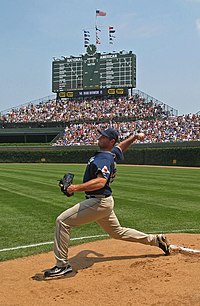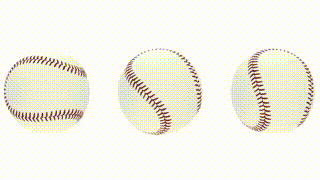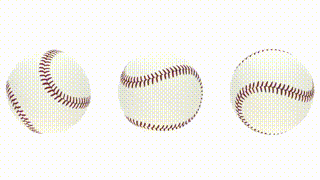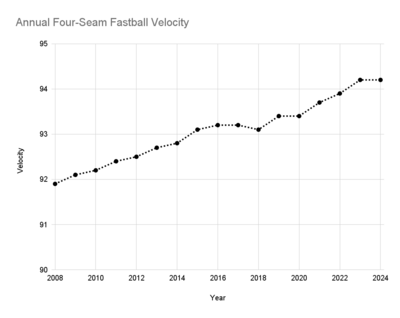| This article needs additional citations for verification. Please help improve this article by adding citations to reliable sources. Unsourced material may be challenged and removed. Find sources: "Fastball" – news · newspapers · books · scholar · JSTOR (October 2011) (Learn how and when to remove this message) |

The fastball is the most common type of pitch thrown by pitchers in baseball and softball. Its distinctive feature is its high speed. "Power pitchers," such as former major leaguers Nolan Ryan and Roger Clemens, relied on the speed, often exceeding 100mph, and movement of their fastballs to prevent the ball from being hit. As an alternative to the fastball, pitchers can put more movement on slower thrown balls, or throw them towards the inside or outside of home plate where batters cannot easily reach it.
Fastballs are usually thrown with a backspin so that the Magnus effect creates an upward force on the ball. This causes it to fall less rapidly than expected, and sometimes causes an optical illusion often called a rising fastball. Although it is impossible for a human to throw a baseball fast enough and with enough backspin for the ball to actually rise, to the batter the pitch seems to rise due to the unexpected lack of natural drop on the pitch.
Colloquially, a fastball pitcher is said to "throw heat" or "put cream on it", among many other variants.
Types of fastballs

Many varieties or 'shapes' of fastballs have been described throughout baseball history, including four-seam fastballs, rising fastballs, two-seam fastballs, sinkers, running fastballs, cut fastballs, and split finger fastballs. However, MLB currently recognizes three distinct types of fastballs, each with substantial variety in terms of movement, consolidating the numerous antiquated descriptors into three groups: four-seam fastballs, sinkers (two-seam fastballs), and cutters (cut fastballs). Despite its name, the split-finger fastball or 'splitter' is not considered to be a type of fastball and is known as an off-speed pitch.
Four-seam fastball
Main article: Four-seam fastball| This section's tone or style may not reflect the encyclopedic tone used on Misplaced Pages. See Misplaced Pages's guide to writing better articles for suggestions. (June 2017) (Learn how and when to remove this message) |

The four-seam fastball is the most common variant of the fastball. The pitch is used often by the pitcher to get ahead in the count or when he needs to throw a strike. This type of fastball is intended to have minimal lateral movement, relying more on its velocity and vertical 'rising' movement. It is typically the fastest pitch a pitcher throws, with recorded top speeds above 100 mph. Two general methods are used to throw a four-seam fastball. The first and most traditional way is to find the horseshoe seam area, or the area where the seams are the furthest apart. Keeping those seams parallel to the body, the pitcher places his index and middle fingers perpendicular to them with the pads on the furthest seam from him. The thumb then rests underneath the ball about in the middle of the two fingers. With this grip, the thumb will generally have no seam on which to rest.

The four-seam fastball is widely regarded as the main key to advancing to the next level of play. One of a baseball scout's main criteria when scouting a prospect is how fast he throws a four-seam fastball.
Sinker (two-seam fastball)
Main articles: Two-seam fastball and Sinker (baseball)The sinker, synonymous with the two-seam fastball, two-seamer, tailing fastball, or running fastball is a type of fastball thrown with a seam orientation that induces more downward or arm-side horizontal movement compared to four-seam fastballs or cutters. Historically, distinctions have been made between these terms, but today, they are all recognized by MLB as variations of the same pitch. Differences in arm slot, spin, and velocity cause some sinkers to exhibit more vertical 'drop' or 'sink', while others 'run' or move more horizontally toward the pitcher's arm side.The unique running and sinking movement profile of the sinker makes it more likely to induce ground balls than other pitches as it sinks under the plane of the batter's swing. Not all fastballs exhibiting sinking or running movement are necessarily sinkers; four-seam fastballs thrown from a low arm slot can also exhibit sinking and running movement due to the horizontal spin axis imparted by a low or sidearm release point.

To throw a sinker, the pitcher typically grips the ball as they would a four-seam, but with their index and middle finger parallel to the seams instead of perpendicular to them. This causes the ball to spin with two seams crossing the plane of spin instead of four.
Throughout much of baseball history, the reasons why a two-seam grip resulted in different ball movement compared to a four-seam fastball were not fully understood. While it was recognized that a reduced spin rate or altered spin axis could create the distinct movement profile of the sinker, it is now understood that the distinctive movement profile of sinkers is primarily due to the seam-shifted wake (SSW) phenomenon.
When a sinker is thrown with a moderate degree of gyro spin and properly oriented seams, the rotating seams around one pole of the baseball create a greater disturbance in the air compared to the seamless area around the other pole. This uneven drag force induces a force perpendicular to the spin direction, typically resulting in more horizontal run, vertical drop, and generally more unpredictable movement than sinkers with less substantial SSW effects. While all pitches experience SSW effects to some degree, sinkers with pronounced seam-shifted movement are understood to be particularly effective pitches, resulting in better outcomes like increased ground ball rates.
The sinker has been a staple for many notable pitchers, often referred to as 'sinkerballers', such as:
- Greg Maddux, widely regarded as among the finest starting pitchers of all time, pitched heavily off his sinker. He relied on its substantial movement, his precise control, and its above average low 90s velocity to generate ground balls as a young pitcher. Towards the end of his career, his velocity declined into the mid 80s, but his excellent sinker helped him remain effective.
- Brandon Webb, one of the most highly regarded pitchers of the 2000s before injuries forced his early retirement, was known for having one of the best sinkers in the league. He relied on this pitch to earn a Cy Young Award and two runner-up finishes from 2006 to 2008.
- Zack Britton, one of the most successful relievers of the 2010s, threw a mid to high 90s sinker more than 90% of the time at his peak. His sinker, now known to have benefitted from substantial seam-shifted wake (SSW) effects, consistently helped him lead the league in ground ball rates.
Cutter (cut fastball)
Main article: Cutter (baseball)
The cutter or cut fastball, is a pitch that blurs the lines between a four-seam fastball and a slider. The pitcher typically shifts their grip on a four-seam fastball to the side of the ball, and slightly supinates their wrist to convert some backspin into gyroscopic spin. This alters the movement of the fastball in several ways.

- Reduces the velocity of the pitch, typically by 2-8 mph compared to the pitchers four-seam velocity, depending on the degree of wrist supination and biomechanical factors.
- Shifts the spin axis of the ball either reducing arm side movement or adding glove side movement.
- Increases gyroscopic spin typically leading to less induced vertical movement and causing the pitch to drop more rapidly than a four-seam fastball.
- Altered seam orientation combining with gyroscopic spin increases seam-shifted wake effects inducing cutting movement to the pitch.
- Many pitchers are able to spin cutters at a higher rate than their four-seam fastball. In MLB in 2024, cutters averaged nearly 2400 RPM compared to around 2300 RPM for the average four-seam fastball.
Combined, these effects typically create a pitch slower than a pitcher's four-seam, that drops faster with either sharp glove-side 'cutting' movement or minimal arm-side movement.
Though the cutter is less common in MLB than the four-seam and the sinker, there have been many notable practitioners such as:
- Mariano Rivera, widely regarded as the greatest relief pitcher in baseball history, relied heavily on a low to mid-90s cutter, at times throwing it almost exclusively. This pitch became notorious for inducing soft contact by cutting in on the hands of left-handed hitters.
- Kenley Jansen, one of the most consistent and decorated relievers of the 2010s, has consistently thrown a low to mid-90s cutter throughout his career. The pitch's heavy seam-shifted wake induced cut has led to elite whiff rates, consistently in excess of 30%, against right-handed hitters.
- Emmanuel Clase relies heavily on his hard cutter. Consistently averaging around 99 mph and reaching as high as 102.8 mph, the pitch has produced extremely high ground ball rates throughout his career.
Velocity

The fastest pitch officially recognized by MLB was a 105.8 mph four-seam fastball thrown by Aroldis Chapman on September 24, 2010.
Since the mid-2000s, MLB has observed a significant increase in fastball velocity among pitchers. In 2008, the average four-seam fastball velocity in the MLB was below 92 mph. This figure has climbed steadily, surpassing 93 mph by 2015, and exceeding 94 mph by 2023. The frequency of pitches exceeding 100 mph further illustrates this trend: in the 2008 regular season, only 214 fastballs reached speeds greater than 100 mph, whereas in 2023, there were 3,848 such pitches. This trend highlights significant advancements in athlete training as well as changes in player evaluation and development.
Increasing fastball velocities have contributed to a number of trends in MLB.
- Higher pitching velocities are associated with greater stress on a pitcher's arm, particularly the elbow and shoulder. Pitch velocity has a significant correlation with injuries such as ulnar collateral ligament tears, necessitating reconstructive surgery.
- Pitchers are less capable of pitching frequently or pitching deep into games due to fatigue and injury concerns associated with throwing harder.
- Emphasis on velocity has been criticized as encouraging homogeneity among pitchers leading to a less aesthetically appealing game. Velocity is encouraged, in part, to elevate pitchers strikeout rates often at the cost of increasing walks, hit batters, and allowing fewer balls in play. While this may improve the overall effectiveness of the pitcher, it might be less appealing for spectators who see less action.
References
- "The Fastest Pitcher in Baseball History". Baseball Almanac, Inc. Archived from the original on 2007-08-12. Retrieved 2007-08-10.
- "Four-Seam Fastball (FA) | Glossary". MLB.com. Retrieved 2024-05-22.
- "Glossary". MLB.com. Retrieved 2024-07-06.
- "Sinker (SI) | Glossary". MLB.com. Retrieved 2024-07-07.
- Blewett, Dan (2022-03-28). "How to Throw a Sinker: The Definitive Guide in 2021 – Grips, Drills & More". Retrieved 2024-07-07.
- ^ Baseball, Driveline (2020-11-02). "An Introduction to Seam-Shifted Wakes and their Effect on Sinkers". Driveline Baseball. Retrieved 2024-07-07.
- Thornley, Stew. "Greg Maddux".
- "Arizona Diamondbacks: The brief and brilliant career of Brandon Webb". Call To The Pen. 2023-01-21. Retrieved 2024-07-07.
- "Zack Britton Stats: Statcast, Visuals & Advanced Metrics". baseballsavant.com. Retrieved 2024-07-07.
- "Statcast Search: 2024 Cutter Characteristics".
- "Kenley Jansen Stats: Statcast, Visuals & Advanced Metrics". baseballsavant.com. Retrieved 2024-07-07.
- "Statcast Search: Emmanuel Clase Peak Velocity". baseballsavant.com. Retrieved 2024-07-07.
- "Emmanuel Clase Stats: Statcast, Visuals & Advanced Metrics". baseballsavant.com. Retrieved 2024-07-07.
- "Statcast Search: >105mph Fastballs". baseballsavant.com. Retrieved 2024-07-07.
- "Statcast Search: Yearly Four-Seam Fastball Velocity". baseballsavant.com. Retrieved 2024-07-07.
- "Statcast Search: >100mph Fastballs".
- Sheinin, Dave (21 May 2019). "Velocity is strangling baseball — and its grip keeps tightening". The Washington Post. Retrieved 22 May 2019.
| Baseball pitches | |||||||
|---|---|---|---|---|---|---|---|
| Fastballs | |||||||
| Off-speed pitches |
| ||||||
| Purpose pitches | |||||||
| Illegal pitches | |||||||
| Other | |||||||
| Deliveries | |||||||
| Related |
| ||||||